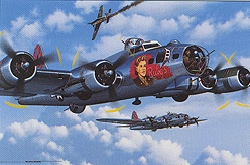|
|
| Ruby's Fortress |
|
 |

|
 |
|
|
| DESCRIPTION |
 |
| 16 x 11.5 Inch Collector Size Unframed Lithograph $40.00
The B-17 "Flying Fortress," was one of the most acclaimed aircraft of WW II. It is also one of those uniquely popular warbirds which has attracted more than its fair share of romance and nostalgia over the years. Nearly 13,000 of these aircraft were produced. The origins of the B-17 dates to 1934 when the Boeing company was authorized to build a prototype of a long-range, metal, monoplane, medium bomber which was designated Model 299. During the first public exposure of the prototype a reporter from the Seattle Daily Times coined the term "flying fortress" in his description of the new sleek, heavily armed aircraft. Boeing's public relations department liked this reference, and shortly thereafter the aircraft became known as the Flying Fortress. Boeing received an initial order for 13 aircraft, designated the YB-17, and these aircraft were delivered in 1937. Later that year Boeing obtained orders for several enhanced models, which were designated B-17B's. These aircraft had supercharged engines permitting higher ceilings, redesigned nose sections, hydraulic brakes, and larger rudders. With the outbreak of WWII the first Flying Fortresses were used by the RAF. Early experience by the RAF underscored the need for increased defensive firepower. Boeing responded by redesigning the entire rear fuselage on the aircraft, and incorporating a rear gun and a remotely controlled under belly turret gun. The resulting B-17E was only slightly slower than its predecessor at 317 MPH, and in mid-1942 the USAAF began moving B-17 units to the United Kingdom. These were primarily B-17F's. Flying Fortresses had the ability to take a lot of punishment. The aircraft's flying characteristics were excellent, and it was not unusual for B-17's to return to base with large sections of wing surface or tail fin missing. The first B-17G models began to see action late in 1943, and were, along with the B-24 Liberators, carried the brunt of the USAAF daylight bombing campaign against targets of strategic significance. Such missions were exceedingly dangerous until only very late in the War. Luftwaffe pilots learned to attack B-17's head-on from the 12 o'clock position, as this was the most vulnerable area to attack, and one in which crew injury was the most likely. Aviation artist Stan Stokes, in his painting entitled Ruby's Fortress, shows a B-17G of the 8th Air Force's 385th Bomber Group over Germany in 1945. The aircraft in the foreground was named for Cpl. Ruby Newell of Long Beach, California. Ms. Newell was voted the most attractive WAC in England in 1944. The nose art painted by Cpl. Ploss was a fitting tribute, and such nose art was a great morale booster for bomber crews and ground support staff. Many B-17's were named after women, appropriate considering the fact that during wartime the majority of the people which built these planes were women. |
|


|